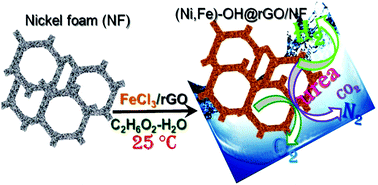rGO functionalized (Ni,Fe)-OH for an efficient trifunctional catalyst in low-cost hydrogen generation via urea decomposition as a proxy anodic reaction†
Abstract
Green hydrogen derived from the water-electrolysis route is emerging as a game changer for achieving global carbon neutrality. Economically producing hydrogen through water electrolysis, however, requires the development of low-cost and highly efficient electrocatalysts via scalable synthetic strategies. Herein, this work reports a simple and scalable immersion synthetic strategy to deposit reduced graphene oxide (rGO) nanosheets integrated with Ni–Fe-based hydroxide nanocatalysts on nickel foam (NF) at room temperature. As a result of synergetic interactions among the hydroxides, rGO and NF, enhanced catalytic sites with improved charge transport between the electrode and electrolyte were perceived, resulting in significantly enhanced oxygen evolution reaction (OER) activity with low overpotentials of 270 and 320 mV at 100 and 500 mA cm−2, respectively, in a 1.0 M KOH aqueous electrolyte. This performance is superior to those of the hydroxide-based electrode without incorporating rGO and the IrO2-benchmark electrode. Furthermore, when the conventional OER is substituted with urea decomposition (UOR) as a proxy anodic reaction, the electrolyzer achieves 100 and 500 mA cm−2 at a lower potential by 150 and 120 mV, respectively than the OER counterpart without influencing the hydrogen evolution reaction (HER) activity at the cathode. Notably, the rGO-incorporated electrode delivers a spectacularly high UOR current density of 1600 mA cm−2 at 1.53 V vs. RHE, indicating the decomposition of urea at an outstandingly high rate.



 Please wait while we load your content...
Please wait while we load your content...